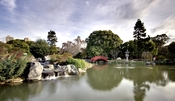Diana Khachatryan
The Japanese Garden
Japan is an island nation of 125.3 million citizens. There are 335 people per square kilometer, making Japan the 16th most densely populated nation in the world.Compared to the United States it is relatively smal in size: 377,727 square kilometers versus 9,372,610.
There are two general types of Japanese gardens: (a) the wet or landscape garden and (b) the dry Zen Buddhist or religous garden. The major differences between them is that insted of water or a pond, the dry garden has raked pebbles that stimulate water. Hence the wet and dry Japanese gardens are functionally equivalent to one another, and both are designed to create a sence of integration betwen the observer and nature and an atmosphere in which meditation can take place. The focus in this chapter is on a wet Japanese garden.
The garden itself serves as a reminder of the centrality of nature to the development of Japanese society, religion, art, and aesthetics: not just nature but the way in which the Japanese perceive nature.
Just as the garden is part of nature , the Japanese tend to view themselves as integral with it. In contrast to the Western view of nature as something to be confronted and subdued, the Japanese genrally see it as something to be accepted.
The three basic elements of the Japanese garden are stone, plants and water. Usually these are combined to form larger elements common to Japanese landscape gardens such as flowing water, ponds, groupings of stones, trees and shrubs, each in as natural appearance as possible to evoke the feeling of artlessness.
To see how the elements of such a garden are manifested in Japanese society, we focus on four topics: wa (harmony) and shikata, or the proper way of doing things,


